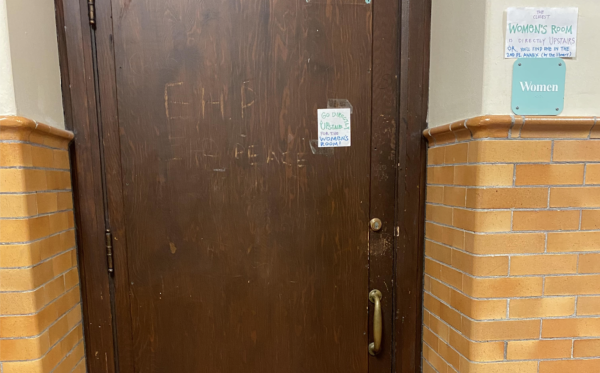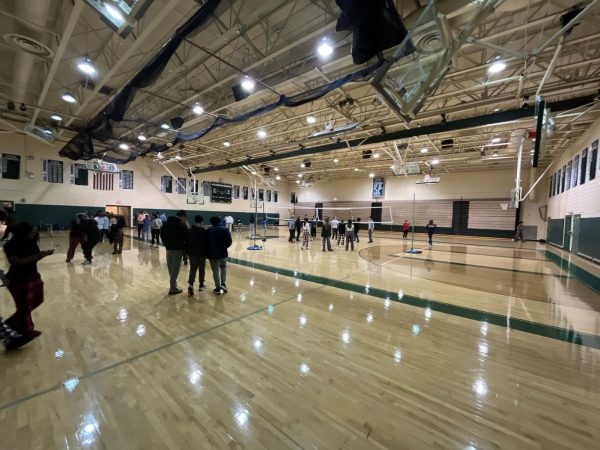Homeroom Timeslot 1 vs Timeslot 3

Allderdice students entering school in the morning.
For the duration of the fall 2021 semester at Allderdice, students experienced a schedule shift: While in past years and now, the 15-minute homeroom block would occur upon the first arrival in the morning, this fall homeroom took place during timeslot 3, at 8:45 AM. Coupled with the fact that PPS start times were shifted from last year and returning amidst a global pandemic, the district found the lack of bus drivers and a clear transportation issue. Allderdice’s start time was moved from 7:35 to 7:15 AM. However, the transportation issue is not the direct cause of the sudden shift in homeroom timing. Principal Dr. McCoy explains that the school had been exploring the idea of having homeroom later than time slot 1 for several years. He explained that as homeroom attendance rates stayed low, Allderdice contemplated changing homeroom time to give students a different motive to arrive at school earlier. “In the past, we considered that people are missing homeroom because they can. If a content class was first, would people come earlier?” Although now the administration returned homeroom back to TS 1, the arguments for and against this change identify interesting points for its impact on high school education.
At the initial decision, Dr. McCoy emphasized how it was consensus among all Department heads at Allderdice that it would be worth trying out homeroom at TS 3. According to a survey conducted by The Foreword (asking this very question), on average, 66% of 57 teachers and staff would prefer homeroom back at timeslot 1. 50% of surveyed teachers estimated that most of their time slot 1 students missed class time each day. In the past, students coming into the building later than usual was not a rarity, however, they have ] 15 minutes to arrive before educational school time is missed. After the change, any late student was immediately missing class time, even if they were just 5 minutes late. Teachers were left reteaching material from the beginning of class dozens of times for each individual student that entered late. When kids came in at different times, one teacher wrote, “It is inconvenient to repeat myself and catch several students up at the same time. Whether a lecture or an independent activity, this makes executing my lesson plan really unpredictable and difficult.” The shift made the teachers’ jobs more difficult in more ways than one.
Other arguments against the later homeroom include the idea that it disrupted the entire flow of the teaching day. A chemistry teacher explained that “It splits my double period so the students come TS 2 then leave for HR and have to come back for TS4.”
Several teachers expressed their discontent with the fact that they could no longer use homeroom to quickly prep for the day. As soon as the bell rang at 7:15, teachers dove right into their lessons, eliminating a small but critical work period they used to get ready for their days.
However, these teachers did find several benefits of a later homeroom block, due to the increase in attendance percentages versus tardy rates. More students who were attending homeroom began receiving pertinent information from the school during the morning announcements or from their homeroom teacher. Also, from an attendance perspective, more students had the opportunity to be “promise ready”, and increase their chances of attending college with financial support from the Pittsburgh Promise.
59% of surveyed Allderdice students voted that they would have preferred keeping homeroom TS 3, rather than making it the first time slot again. Many students enjoyed the break that TS 3 homeroom offered. Between the first two periods of the day and students’ lunch periods, they had a chance to see their friends or catch up on work. 44% of surveyed students claimed that they did not really worry about missing TS 1 class, even if it was against their best interest. Students could have technically been tardy to school, without having received administrative repercussions. An anonymous student wrote, “It gives kids a chance to get marked present during the day, without being penalized for the early start time of the school day.”
A majority of Allderdice students who use public transportation or school buses don’t have complete control over what time they arrive at school. Having the homeroom period later ensured that they didn’t have any tardy consequences for something out of their control, even if they were missing crucial class time.
Despite the support for keeping homeroom timeslot 3, 52% of surveyed Allderdice students stated that they missed significant time slot 1 class time most days. 78% of these students said that they arrived within 20 minutes of the first-period bell. This means that by having the homeroom 15 minutes at the very beginning of the day, most of these students would be in the building in time for their first-period classes. These 20 minutes of missed class time were significant as well: many of the surveyed teachers and students agreed that their timeslot 1 class grades struggled. The students missing class were affected most.
Compared to previous years, content classes started an entire 45 minutes earlier. One student wrote, “We don’t get a relaxed start to the morning, we immediately have to start learning and have no time to wake up… Since I have first-period math, my ability to learn in that class is inhibited by my feeling of being tired.” Countless studies and research across the world, including from the CDC, prove that having educational classes later in the morning leads to much better-improved comprehension and success capability.
Some students are conflicted: an anonymous student shared, “My bus driver is consistently late, and sometimes she doesn’t come at all. I’ve been missing class time every day, and my [timeslot 1] Chemistry grade is not very good. Not really sure which I prefer though. I now definitely get to homeroom on time every day. Last year, I’d be tardy all the time and face consequences, but now I’m nearly never tardy to the homeroom.”
One teacher said, “I know the overall attendance records ‘look’ better with it being later in the day,” addressing the idea that a shift in homeroom might have made the school look better, even if it was against the best interest of the students or staff. It was a valid idea, however, as the percent of tardies had significantly decreased since the time slot 3 shift. The idea that a later homeroom decreased tardiness coming from Allderdice for administrative reasons was very valid, but it could have also helped students themselves. Being Promise Ready includes having at least 90% attendance, and this change could have helped hundreds more Allderdice students receive that scholarship, given that they fulfilled the rest of the requirements.
However, Dr. McCoy claimed that there were no such alternative motives from the administration, saying that “It was solely put under consideration for the benefit of students struggling to get to school on time. We are still testing it out to see which time slot is most effective.”
After a semester observing how the “homeroom shift” affected attendance, grades, and students’ mental health, the administration decided to change homeroom back to timeslot 1. Dr. McCoy emphasized, “The decision was made for the overall best interest of every student, and we will ensure that it is designed to prevent further detriment to timeslot 1 content classes.”
Anisha Willis is a senior at Pittsburgh Allderdice High School. She is a Co-Editor-in-Chief, and is a 4 year staff writer for the Foreword. Outside of...






